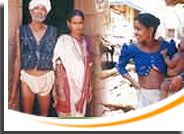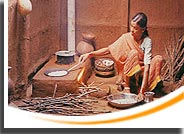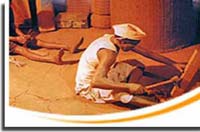History
There is no documented history of the origins of Dhodia Tribe. Folklores passed from generation to generation as well as archealogical evidences propose various theories. The most popular theory among old people we hear is that the Jadhav Rajput descendents of Lord Krishna called Dhana and Roopa came from Dwarka to settle down in Dholka Dhandhuka near the Narmada. They came with thousands of people from their community to the region of South Gujarat and married women called Sani and Jheeni of the local Naika community. Since they came with a lot of cattle (dhor),this community was called "Dhorwala" which then changed to Dhodia. There could be some truth in this theory because essentially the Jadhav's are known to be cowherds.
In the northern part of India, there are Rajput communities called Garasiya and a lot of Dhodia kuls (individual clans) have names that have Garasiya. In present day Saurastra, there are Rajput communities which bear the second name of Dodiya which also sounds close to Dhodiya. Dhodias are considered as the third largest tribal group in Gujarat. They mainly inhabit the extreme south-eastern districts of the state. Their villages lie in the hilly regions south of the Tapi River. Dhodia, a Bhil language, is the dialect spoken by this tribe. Dhodias are related to the Bhil tribes of India. Unlike other Bhils, Dhodias do not use bows and arrows. They also participate in festivals with the Hindus who live nearby. The Dhodia are also located in Dadra & Nager Haveli.
Origin
The Dhodia are the highest ranking tribe and the third largest tribal group in Gujarat. They speak Dhodia, a Bhil language. Long ago, prosperity within Gujarat State attracted people from all the surrounding states. Gujarat was targeted by the Maratha tribes, who made annual raids to the region for several years. Eventually, the Muslims took over the area east of Surat in order to reap its economic benefits. War continued between the Mughals, the Maratha, and the Portuguese over the Gujarat territory. By 1817, The Brtitish was in power. Later In the years that followed, they attempted to mend what the Maratha had left by dispersing farmland among the settlers. In 1930, Mahatma Gandhi demanded the British to withdraw from India. The Dhodia, a non-aggressive people, retreated deeper into the hills during the conflict.
Culture
The Dhodia tribe consider themselves to be of a higher class than the neighboring Bhil groups. They will not marry other Bhil or even eat with them. They have more than one wife when they can afford it. The wives are "bought" while they are still young girls. In the past, it was customary to take the bride to the groom's house for the wedding. Today, however, the young couple generally travel to the bride's house to be married. A widow usually remains a part of her husband's family by marrying her deceased husband's brother. The Dhodia participate in festivals alongside the Hindus who live nearby. They are not really community-minded, but only come together for such things as annual communal fishing and religious feasts. Village leaders perform certain social duties.
Place /Location (then and now) |
Gujarat |
Population |
200,00 |
Languages spoken |
Dhodia a Bhil Language |
Religion/God |
"Kanseri" (Goddess of food) , Hinduism
|
Food |
Rice, Wheat, Jowar and Pulses like tur, moong, urad , etc |
Living conditions

ssss They are small bamboo huts made with tiled roofs. The poorer Dhodia live in mud huts that they build themselves. The doors always face north in order to prevent interaction with evil spirits.
People
The Dhodia go to the markets to trade their crops for clothing. The women wear blouses under dark green or red cotton saris (long pieces of cloth that are wrapped around the waist and over one shoulder). They also wear necklaces made of lead beads and rupee coins, and silver anklets. Most of the men wear either a "Gandhi" cap or a turban wrapped out of a piece of cloth. Shorts have also become popular among the men.
Food

Their staple food is rice, wheat and jowar. Pulses of tur, urad, moong, wal and gram also make their part of the diet .
Occupation
Their main source of livelihood is agriculture. Some of them prefer hunting and fishing. Dhodias usually live in small bamboo huts made with tiled roofs.

Forest labor, trade labor (in the cities), hunting, and fishing are secondary to agriculture. Some live in the Surat district, an area well known for its rich soils and fine cotton crop.
Others live in areas where, because of the heavy rainfall, they are able to cultivate rice. Still others live in the less fertile, highland areas.
Festivals
The Dhodia Tribe celebrates all the festivals that other Hindus do."Diwali","holi" and others.The majority of Dhodia believe in and are devoted to "Kanasari" or "Kanseri" (Goddess of food). They celebrate the "Kanseri" annually at harvest. The "Kaneseri" Goddess means the Goddess "Annapurna".The Dhodia also celebrate "Divaso".Vagh Baras is also celebrated in a unique fashion in some Dhodia villages where, men colour themselves in stripes representing the Vagh and others as plain white or other colours denoting cattle. The tiger chases the cattle. Finally at the end of the sport the village inhabitants eat food together at a common place and celebrate.


